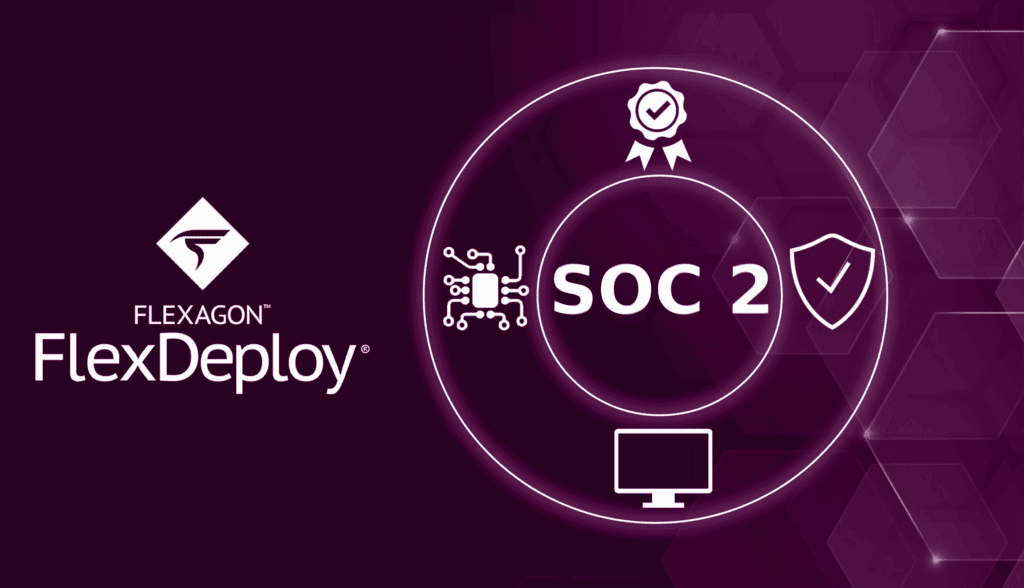Today Flexagon released FlexDeploy 5.0 which includes a wealth of new features, enhancements, and usability improvements to help teams deliver high-quality software faster and with less cost and risk.
FlexDeploy is a DevOps platform for Continuous Delivery and Release Automation which provides a comprehensive and integrated platform for orchestrating the entire build, deploy, and release lifecycle. Users can capitalize on their investments and innovate faster, with extensive automation, improved controls, and visibility to information like never before. FlexDeploy is an open and extensible platform which includes pre-built content for commercial and open source technology. Examples include Oracle Middleware and E-Business Suite, MuleSoft, WebSphere, Salesforce, Informatica, ServiceNow, Jira, Git, Kubernetes, Selenium, and many other commercial and open source tools and technologies running on-premises and in the cloud.
A few highlights in FlexDeploy 5.0
Microservices, Containers, Container Orchestration Engines, Serverless: We have enriched our plugin SDK to enable FlexDeploy plugins to be created as Docker containers, providing freedom of tools to build plugins and freedom in terms of dependency from infrastructure. FlexDeploy executes those plugins as Docker containers acting as a serverless platform. Additionally, FlexDeploy can be run as a container, allowing users to pull it, start it, and run it on their choice of Docker or Kubernetes runtimes. Read More about this update. FlexDeploy 5.0 includes enhancements to the Docker plugin and a new Kubernetes plugin. The additional Docker plugin operations simplify the operational management of Docker containers, and a new Kubernetes plugin provides a means to manage resources (deployments, pods, services, etc.) in a K8s cluster by performing various Kubectl commands, including apply, label, and delete.
Oracle E-Business Suite Post-Cloning Optimizations: Cloning is integral to every EBS implementation. Regularly refreshing data from production is a best practice and the best way to keep your environments accurate. Unfortunately for those running these processes, development never stops, so after data refreshes the team needs to reapply changes. FlexDeploy’s newest EBS feature solves the challenge of applying changes after the clone has happened by automating the post-cloning process, making it simple to redeploy customizations to refreshed environments.
Reporting and Dashboard Enhancements: We have improved the extensibility of reporting by allowing FlexFields to be searchable and a field that can be reported on. Additionally, users can now run reports based on change tickets from ServiceNow or Jira issues, allowing for additional traceability. With FlexDeploy, users have an audit trail for end-to-end traceability. There is flexibility to slice and dice the data in many ways since everything is documented. Users know what happened to start the lifecycle (who authorized what change), when it finished (was released to production) and everything in between.
Rest APIs: We have enhanced REST APIs for third-party integration and external management of FlexDeploy. This builds out the already robust extensibility of the platform by allowing others to build their own tools around FlexDeploy and to more easily manipulate and manage FlexDeploy activities using alternative channels. Bottom line, you can drive FlexDeploy via our robust UI or APIs. Your choice and flexibility to meet whatever needs you might have. See our API Guide for more details.
Usability and Ease of Adoption: FlexDeploy 5.0 includes many enhancements, utilities, and general usability improvements which help ease the adoption and ongoing care and feeding post-implementation. Examples include new tutorials, Docker version of FlexDeploy, fine-tuning the UI for optimal User Experience, and advanced administration related to purging and archiving release level data.
Plugins and Integrations: In addition to the enhancements for container related plugins mentioned above, there are many improvements to other plugins such as Oracle EBS, Middleware, Cloud, and other open source and commercial tools/products. For example, a new Oracle Integration Cloud plugin which exports and imports integrations running in the OIC, making it easy to move integrations through multiple environments. There are also improvements to the Oracle EBS plugin and many others to plugins such as JDBC, File, Oracle Database, WebLogic, and Partial Build/Deploy features.
You can see more details in our Release Notes, or feel free to reach out to us to explore these new features in more detail.


